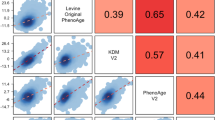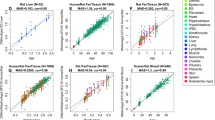Abstract
Little systematic knowledge exists concerning the impacts of cumulative lifelong exposure, termed the exposome, on requirements for nutrients. Phenylalanine (Phe) is an essential dietary amino acid with an aromatic ring structure similar to endogenous metabolites, dietary compounds and environmental agents. Excess plasma Phe in genetic disease or nutritional deficiency of Phe has adverse health consequences. In principle, structurally similar chemicals interfering with Phe utilization could alter Phe requirement at an individual level. As a strategy to identify components of the exposome that could interfere with Phe utilization, we tested for metabolites correlating with Phe concentration in plasma of a non-human primate species, common marmosets (Callithrix jacchus). The results of tests for more than 5,000 chemical features detected by high-resolution metabolomics showed 17 positive correlations with Phe metabolites and other amino acids. Positive and negative correlations were also observed for 33 other chemicals, which included matches to endogenous metabolites and dietary, microbial and environmental chemicals in database searches. Chemical similarity analysis showed many of the matches had high structural similarity to Phe. Together, the results show that chemicals in marmoset plasma could impact Phe utilization. Such chemicals could contribute to early lifecycle developmental disorders when neurological development is vulnerable to Phe levels.







Similar content being viewed by others
Abbreviations
- CAS:
-
Chemical abstracts service
- CID:
-
PubChem compound ID
- FDR:
-
False discovery
- KEGG:
-
Kyoto encyclopedia of genes and genomes
- LC–MS:
-
Liquid chromatography–mass spectrometry
- m/z :
-
mass to charge
- MWAS:
-
Metabolome-wide association study
- Phe:
-
Phenylalanine
- PPAR-γ:
-
Peroxisome proliferator-activated receptor-γ
- RT:
-
Retention time
References
Anastasoaie V, Kurzius L, Forbes P, Waisbren S (2008) Stability of blood phenylalanine levels and IQ in children with phenylketonuria. Mol Genet Metab 95:17–20
Banay-Schwartz M, Palkovits M, Lajtha A (1993) Heterogeneous distribution of functionally important amino acids in brain areas of adult and aging humans. Neurochem Res 18:417–423
Benjamini Y, Hochberg Y (1995) Controlling the false discovery rate: a practical and powerful approach to multiple testing. J R Stat Soc Ser B 57:289–300
Blau N, van Spronsen FJ, Levy HL (2010) Phenylketonuria. Lancet 376:1417–1427
Bolton EE, Wang Y, Thiessen PA, Bryant SH (2008) PubChem: integrated platform of small molecules and biological activities. In: Ralph AW, David CS (eds) Annual Reports in Computational Chemistry, vol 4. Elsevier, pp 217–241
Collino S et al (2013) Metabolic signatures of extreme longevity in northern Italian centenarians reveal a complex remodeling of lipids, amino acids, and gut microbiota metabolism. PLoS One 8:e56564
Deo RC et al (2010) Interpreting metabolomic profiles using unbiased pathway models. PLoS Comput Biol 6:e1000692
Droge W, Kinscherf R (2008) Aberrant insulin receptor signaling and amino acid homeostasis as a major cause of oxidative stress in aging. Antioxid Redox Signal 10:661–678
Farishian RA, Whittaker JR (1980) Phenylalanine lowers melanin synthesis in mammalian melanocytes by reducing tyrosine uptake: implications for pigment reduction in phenylketonuria. J Invest Dermatol 74:85–89
Fujita S, Volpi E (2006) Amino acids and muscle loss with aging. J Nutr 136:277S–280S
Fukagawa NK, Minaker KL, Rowe JW, Matthews DE, Bier DM, Young VR (1988) Glucose and amino acid metabolism in aging man: differential effects of insulin. Metabolism 37:371–377
Hitsman B et al (2008) Effects of acute tyrosine/phenylalanine depletion on the selective processing of smoking-related cues and the relative value of cigarettes in smokers. Psychopharmacology 196:611–621
Hsu JW, Goonewardene LA, Rafii M, Ball RO, Pencharz PB (2006) Aromatic amino acid requirements in healthy men measured by indicator amino acid oxidation. Am J Clin Nutr 83:82–88
Johnson JM, Yu T, Strobel FH, Jones DP (2010) A practical approach to detect unique metabolic patterns for personalized medicine. Analyst 135:2864–2870
Johnson SC, Rabinovitch PS, Kaeberlein M (2013) mTOR is a key modulator of ageing and age-related disease. Nature 493:338–345
Jones DP, Park Y, Ziegler TR (2012) Nutritional metabolomics: progress in addressing complexity in diet and health. Annu Rev Nutr 32:183–202
Kadowaki K, Fukino K, Negishi E, Ueno K (2007) Sex differences in PPARgamma expressions in rat adipose tissues. Biol Pharm Bull 30:818–820
Kaufman S (1999) A model of human phenylalanine metabolism in normal subjects and in phenylketonuric patients. Proc Natl Acad Sci USA 96:3160–3164
Krishna RV, Krishnaswamy PR, Rao DR (1971) Enzymic synthesis of N-acetyl-l-phenylalanine in Escherichia coli K12. Biochem J 124:905–913
Lee PJ et al (2009) Adults with late diagnosed PKU and severe challenging behaviour: a randomised placebo-controlled trial of a phenylalanine-restricted diet. J Neurol Neurosurg Psychiatry 80:631–635
Miller GW, Jones DP (2014) The nature of nurture: refining the definition of the exposome. Toxicol Sci 137:1–2
Miller RA, Buehner G, Chang Y, Harper JM, Sigler R, Smith-Wheelock M (2005) Methionine-deficient diet extends mouse lifespan, slows immune and lens aging, alters glucose, T4, IGF-I and insulin levels, and increases hepatocyte MIF levels and stress resistance. Aging Cell 4:119–125
Okano Y, Nagasaka H (2013) Optimal serum phenylalanine for adult patients with phenylketonuria. Mol Genet Metab 110:424–430
Phinney KW et al (2013) Development of a standard reference material for metabolomics research. Anal Chem 85:11732–11738
Rappaport SM, Smith MT (2010) Epidemiology. Environment and disease risks. Science 330:460–461
Roede JR, Uppal K, Liang Y, Promislow DE, Wachtman LM, Jones DP (2013) Characterization of plasma thiol redox potential in a common marmoset model of aging. Redox Biol 1:387–393
Schumacher U et al (2008) High concentrations of phenylalanine stimulate peroxisome proliferator-activated receptor gamma: implications for the pathophysiology of phenylketonuria. Neurobiol Dis 32:385–390
Simon-Manso Y et al (2013) Metabolite Profiling of a NIST Standard Reference Material for Human Plasma (SRM 1950): GC-MS, LC-MS, NMR, and Clinical Laboratory Analyses, Libraries, and Web-Based Resources. Anal Chem 85:11725–11731
Smith CA et al (2005) METLIN: a metabolite mass spectral database. Ther Drug Monit 27:747–751
Soltow QA, Strobel FH, Mansfield KG, Wachtman L, Park Y, Jones DP (2013) High-performance metabolic profiling with dual chromatography-Fourier-transform mass spectrometry (DC-FTMS) for study of the exposome. Metabolomics 9:132–143
Solverson P, Murali SG, Litscher SJ, Blank RD, Ney DM (2012) Low bone strength is a manifestation of phenylketonuria in mice and is attenuated by a glycomacropeptide diet. PLoS One 7:e45165
Stegink LD, Koch R, Blaskovics ME, Filer LJ Jr, Baker GL, McDonnell JE (1981) Plasma phenylalanine levels in phenylketonuric heterozygous and normal adults administered aspartame at 34 mg/kg body weight. Toxicology 20:81–90
Tardif SD, Smucny DA, Abbott DH, Mansfield K, Schultz-Darken N, Yamamoto ME (2003) Reproduction in captive common marmosets (Callithrix jacchus). Comp Med 53:364–368
Udenfriend S, Cooper JR (1953) Assay of l-phenylalanine as phenylethylamine after enzymatic decarboxylation; application to isotopic studies. J Biol Chem 203:953–960
Uppal K, Soltow QA, Strobel FH, Pittard WS, Gernert KM, Yu T, Jones DP (2013) xMSanalyzer: automated pipeline for improved feature detection and downstream analysis of large-scale, non-targeted metabolomics data. BMC Bioinform 14:15
Wachtman LM, Miller AD, Xia D, Curran EH, Mansfield KG (2011) Colonization with nontuberculous mycobacteria is associated with positive tuberculin skin test reactions in the common marmoset (Callithrix jacchus). Comp Med 61:278–284
Waisbren SE, Noel K, Fahrbach K, Cella C, Frame D, Dorenbaum A, Levy H (2007) Phenylalanine blood levels and clinical outcomes in phenylketonuria: a systematic literature review and meta-analysis. Mol Genet Metab 92:63–70
Wanders D, Ghosh S, Stone KP, Van NT, Gettys TW (2014) Transcriptional impact of dietary methionine restriction on systemic inflammation: relevance to biomarkers of metabolic disease during aging. Biofactors 40:13–26
Wild CP (2005) Complementing the genome with an “exposome”: the outstanding challenge of environmental exposure measurement in molecular epidemiology. Cancer Epidemiol Biomark Prev 14:1847–1850
Willett P, Barnard J, Downs G (1998) Chemical similarity searching. J Chem Inf Comput Sci 38:983–996
Yu T, Park Y, Johnson JM, Jones DP (2009) apLCMS–adaptive processing of high-resolution LC/MS data. Bioinformatics 25:1930–1936
Acknowledgments
The authors gratefully acknowledge the technical expertise of Yongliang Liang and ViLinh Tran for mass spectrometry analyses. This study was supported by NIH grants, AG038746 (D.J., D. P., L.W.), ES023485 (D.J, Y.G.), ES009047 (D.J.), HL113451 (D.J.) and ES019776 (D.J.).
Conflict of interest
Authors have no conflicts of interest.
Author information
Authors and Affiliations
Corresponding author
Electronic supplementary material
Below is the link to the electronic supplementary material.
Rights and permissions
About this article
Cite this article
Go, YM., Walker, D.I., Soltow, Q.A. et al. Metabolome-wide association study of phenylalanine in plasma of common marmosets. Amino Acids 47, 589–601 (2015). https://doi.org/10.1007/s00726-014-1893-x
Received:
Accepted:
Published:
Issue Date:
DOI: https://doi.org/10.1007/s00726-014-1893-x




